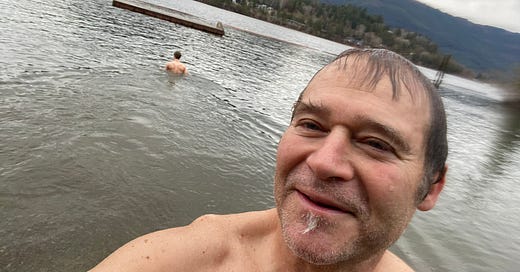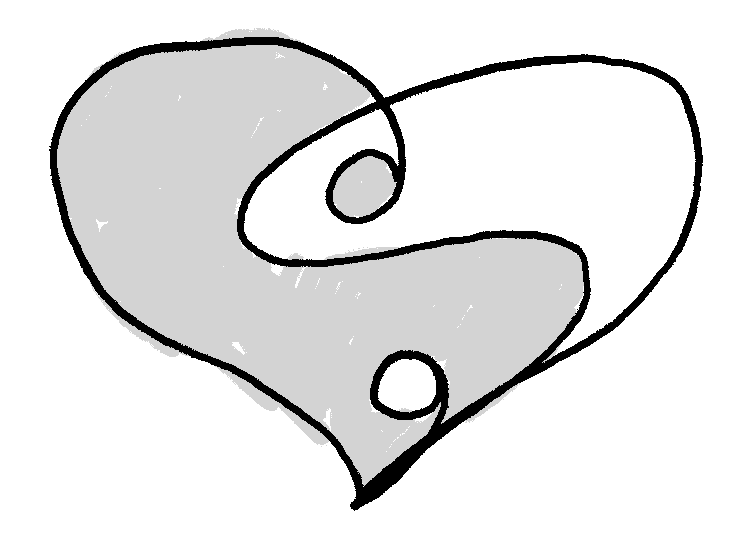Cold and Warm
On New Year’s Day, my son and I participated in the local Polar Bear Swim in Cowichan Lake. I managed to stay in the water for about fifteen minutes—which was not bad considering most participants were in and out in less than half a minute. When one jumps into a lake on a zero-degree day, there is a tendency for the muscles to contract and shiver. This is the body’s first-instinct way of generating heat quickly.
It is also possible to approach the cold-water dilemma with an internal-arts method.
Rather than giving-in to my body’s desire for instant heat, I relax my muscles and then practice Full Taiji Breathing using the Five Words of Self Composure. ‘Passive inhalation, active inhalation’—‘breath.’ ‘Passive exhalation’—‘calm, centre, root.’ ‘Active exhalation’—‘energy.’ Over and over. Although it takes a while, the heat begins to build from deep inside.
Active-passive, inhale-exhale, outer-cold, inner-warmth, these are all yin and yang ideas.
Yin and Yang
The yin-yang (阴阳) concept has ancient roots. Many Chinese cultural traditions have adopted its hypothesis of complementary opposites to explain ideas and organize information. The yin-yang concept holds that all things exist in a condition of fluctuating balance—this is represented by yin and yang elements that diminish and increase in relation to one another like the crests and troughs of waves in a body of water.
Examples of yin-yang pairings include ‘cold and hot,’ ‘inside and outside,’ ‘dark and bright,’ ‘empty and full,’ ‘concave and convex,’ etc. The health and martial-arts features taijiquan can be thought of as the yin and yang aspects of the art. Widely recognized, the taiji diagram (taiji tu 太极图)—often referred to simply as the ‘yin-yang’—has been used to represent this yin and yang interchange and has come to serve as a something of a logo for the art of taijiquan generally.

Here are two yin-yang ideas to meditate on as we dive into 2024.
Acceptance and Responsibility
From a certain perspective, we are very, very small. Unimaginable macrocosmic forces determine our capability at all times. We are dwarfed by the size of the earth that is estimated to travel at over 100,000 kilometres per hour around a star that is traveling eight times that speed through the galaxy. Once, as we stood on a mountaintop in Connecticut, my teacher Grandmaster Liang Shou-Yu said, ‘Human small, mountain big. Mountain small, earth big. Earth small, solar system big. Solar system small, galaxy big, galaxy small, universe big.’
Dare one add, ‘etcetera?’
Contemplating these scalar realities, the scope of one’s existence seems unfathomably minute. A person who believes oneself to be ‘in control’ in such a scheme might be seen as somewhat potty.
When considering one’s place in the universe, both in terms of the staggering dimensionality as well as the magnitude of forces at play in the cosmos, an attitude of ACCEPTANCE for one’s lot might be in order.
At the same time, as small as we are, we can make choices—at least in some areas. Furnished with a unique ability to convert introspection into narrative and narrative into action, we can affect self and others beneficially or adversely. And given that introspection and endeavour are bound up in choice and habit (and that choices have consequences) a healthy mental attitude might include a sense of RESPONSIBILITY.
An attitude of acceptance is needed to deal with that which is not under one’s control, things which one cannot change, and also for things that already passed. Whereas, responsibility belongs to what is becoming, what one can affect, and what can be undertaken in future. Here, ‘balancing yin and yang’ might be seen as cultivating the ability to sense whether a given situation requires a focus mainly on giving-into acceptance or taking-on responsibility (could we say ‘response-ability?’).
Of course, as with all things yin-yang, there needs be some of each in the other. The yin-yang concept holds that all things exist in a condition of fluctuating balance—this is represented by yin and yang elements that either diminish or increase in relation to one another like the crests and troughs of waves in a body of (very cold) water. Thus, acceptance entails a degree of responsibility. And, taking on responsibility is something that must be accepted.
Hope and Courage
HOPE is often associated with positive emotions such as happiness, joy, and a general belief in a favourable future. To have ‘hope’ is felt as empowering and motivating. Hope is sometimes seen as the opposite of skepticism.
Hope (Xiwang 希望)
Humans hope for happiness just as trees look forward to spring. 人望幸福, 树望春。
Hope often comes-to-fore when a crisis looms but may wither when the going gets tough. It is here that COURAGE functions to empower. Whereas, abiding hope is sometimes criticized as unrealistically idealistic depending on the harshness or complexity of circumstances, courage is seen as the means to keep going even when the situation seems dire.
Courage (Yongqi 勇气)
The courageous act in service of their courage. 敢作敢当。
Both hope and courage are understood as relating to the metaphorical ‘heart.’ A ‘heart full of hope’ is axiomatic. The word ‘courage’ is derived from the Latin cor literally meaning ‘heart.’ Whereas hope is for the future to come, courage is for the present to be dealt with.
Somehow, ‘hope’ seems softer than ‘courage,’ nevertheless both qualities require a certain toughness of spirit, an ability to overcome the disheartening opposites of ‘despair’ and ‘discouragement.’
Perhaps the duo of ‘hope’ and ‘courage’ can be seen in relation to ‘acceptance’ and ‘responsibility.’ Hope emerges more naturally when if one accepts while courage is needed to bear responsibility.
Almost everything we do in taijiquan is counterintuitive. We seek to re-contextualize instinctive first-nature reactions so that they may be triggers for principled second-nature responses. Physio-neurological re-patterning and retraining make taijiquan a true art of self-cultivation. Yin-yang concepts such as those explored here can help in this process as we accept our smallness to take responsibility for our greatness.
Our art is one of flexibility, listening, learning, finding root and centre, and moving with what is unfolding as it does so. As we connect and join with what comes our way (ACCEPTANCE), we seek to deepen trust in our structure through determined and principled practice (RESPONSIBILITY). We patiently persist so that we may improve and self-transform (HOPE) and dig in deep to master those things that confront and challenge us (COURAGE).
Jump in cold water and breathe deeply!
And a happy new year…












great, you have put the usually vague and slippery concept of yin/yang into a real practical context here. no small thing. thanks
Pema Chodron talks about hopelessness. How abandoning hope(acceptance) and how hope can sometimes leave us holding on waiting and held hostage by our suffering instead of investigating and accepting those parts of our lives and selves. I have always found this notion to have merit for myself. I like how you seem to describe a more complex character of hope and courage. A relationship to overcoming the despair that hope follows and the courage to move through it. Again, describing a relationship, an ebb and flow. A snippet from Pema - just in case your curious. “To stay with a broken heart, with a rumbling stomach, with the feeling of hopelessness and wanting to get revenge—that is the path of true awakening. Sticking with that uncertainty, getting the knack of relaxing in the midst of chaos, learning not to panic—this is the spiritual path.” ~ Pema Chödrön